Trespass Warning Letter
[Your Name]
[Your Address]
[City, State, Zip Code]
[Email Address]
[Phone Number]
[Date]
[Recipient's Name]
[Recipient's Address]
[City, State, Zip Code]
Subject: Trespass Warning
Dear [Recipient's Name],
I hope this letter finds you well. I am writing to inform you that you are hereby issued a formal trespass warning. This decision has been made due to your repeated unauthorized presence on my property, which is located at [Your property address]. Despite prior verbal warnings, you have persisted in trespassing on the premises, causing a disturbance and infringing upon my right to enjoy a peaceful and secure environment.
Trespassing is a violation of both legal and ethical boundaries, and I am left with no choice but to take legal action if this behavior continues. I value the privacy and safety of my property, and any further unauthorized entry will be considered a deliberate disregard for my rights as a property owner.
This letter serves as an official notice to cease all unauthorized entry onto my property immediately. Failure to comply with this warning may result in legal action, including seeking a restraining order, filing a police report, or pursuing other remedies available under the law.
I sincerely hope that it does not come to that, and I expect you to respect my rights as a property owner. I trust that you will take this warning seriously and refrain from any future trespassing on my property.
If you have any questions or concerns regarding this matter, please do not hesitate to contact me at [Your Phone Number] or [Your Email Address]. I strongly advise you to act responsibly and respect the boundaries of private property to avoid any further complications.
Thank you for your understanding and immediate attention to this matter.
Sincerely,
[Your Name]
Formal Trespass Warning Letter
Dear [Recipient Name],
This letter serves as a formal notice that you are not authorized to enter or remain on the property located at [Property Address]. Any unauthorized presence on this property will be considered trespassing.
You are hereby warned to refrain from entering the premises. Failure to comply may result in legal action as permitted by law.
Sincerely,
[Sender Name]
[Title / Property Owner]
[Company or Organization Name]
Provisional Trespass Warning Letter
Dear [Recipient Name],
We have received reports of unauthorized access to [Property Address]. This letter serves as a provisional warning to cease any entry until further notice.
Please be advised that continued presence on the premises without permission may lead to legal enforcement.
Regards,
[Sender Name]
[Title / Property Owner]
Informal Trespass Warning Message
Hi [Recipient Name],
You are not allowed to enter [Property Address] without permission. Please stay off the property to avoid any issues.
Thanks,
[Sender Name]
Official Trespass Warning Letter for Tenants
Dear [Tenant Name],
This notice is to inform you that any unauthorized guests entering [Property Address] without prior approval are in violation of your lease agreement. Unauthorized access constitutes trespassing and may lead to legal action.
Please ensure compliance with all property regulations immediately.
Sincerely,
[Landlord / Property Manager Name]
[Title]
[Company Name]
Security-Focused Trespass Warning Letter
Dear [Recipient Name],
It has come to our attention that you have been entering [Property Address] without authorization. For the safety and security of the premises, you are hereby warned not to return without explicit permission.
Violation of this notice will result in immediate involvement of law enforcement.
Regards,
[Security Manager Name]
[Title]
[Organization Name]
Community Trespass Warning Notice
Dear [Recipient Name],
Members of [Community/HOA Name] are reminded that entry to [Property Address / Community Area] without permission is strictly prohibited. Trespassing may result in penalties as outlined in community regulations.
Please respect private property boundaries.
Thank you,
[HOA / Community Manager Name]
Quick Trespass Warning Email
Hello [Recipient Name],
This is to notify you that you are not authorized to enter [Property Address]. Please refrain from doing so to avoid legal consequences.
Thank you,
[Sender Name]
Heartfelt Trespass Warning Letter
Dear [Recipient Name],
We value the safety and harmony of [Property Address]. It has been noted that you have entered the premises without permission. We kindly request that you respect this property and refrain from unauthorized access.
Your cooperation is greatly appreciated.
Warm regards,
[Sender Name]
[Title]
What / Why You Need a Trespass Warning Letter
- Provides formal notice to individuals that they are not authorized to enter a property
- Serves as a legal record to support enforcement if trespassing continues
- Helps protect property, residents, and staff from unauthorized access
- Communicates boundaries clearly and prevents misunderstandings
Who Should Send a Trespass Warning Letter
- Property owners or landlords
- Business managers or company officials
- Security managers or supervisors
- Homeowners’ association representatives
Whom Should Receive a Trespass Warning Letter
- Individuals caught or suspected of unauthorized entry
- Tenants violating property rules
- Employees or contractors accessing restricted areas without permission
- Members of the public encroaching on private or protected property
When to Send a Trespass Warning Letter
- After detecting unauthorized entry or repeated trespassing
- Before initiating legal action for trespassing
- When warning tenants about lease violations
- In response to security breaches in sensitive areas
How to Write and Send a Trespass Warning Letter
- Identify the recipient and property clearly
- State that the entry is unauthorized and constitutes trespassing
- Explain potential consequences if the warning is ignored
- Use a formal tone for legal enforceability; informal tone for initial notices if appropriate
- Include sender’s name, title, and contact information
- Deliver via registered mail for formal letters or email for quick notification
How Many Details Should Be Included
- Property address and description
- Date(s) of unauthorized entry if known
- Specific warnings or consequences
- Contact details for further inquiries or compliance confirmation
Formatting Tips for Trespass Warning Letters
- Length: concise, 1–2 pages for letters, 1–2 paragraphs for emails
- Tone: formal, serious, and unambiguous
- Wording: clear and direct; avoid overly aggressive or emotional language
- Style: letter for legal or official purposes, message/email for immediate alerts
- Etiquette: respectful but firm
Requirements and Prerequisites Before Sending
- Verify property ownership or authorization to issue warnings
- Document instances of trespassing or unauthorized access
- Determine legal implications and potential follow-up actions
- Collect recipient’s contact information and previous warnings if any
After Sending / Follow-up Actions
- Track whether the recipient complies with the warning
- Involve law enforcement if trespassing continues
- Maintain records of all warnings sent for legal protection
- Update security measures or property access controls as needed
Tricks and Tips for Effective Trespass Warning Letters
- Keep the language professional and neutral
- Include clear property boundaries and dates of incidents
- Send via certified mail to create an official record
- Provide contact information for queries or dispute resolution
- Use consistent formatting for all warning letters
Common Mistakes to Avoid
- Using vague or ambiguous language
- Failing to document the trespassing event
- Sending warnings without proper authority
- Overly aggressive or emotional wording that could escalate disputes
- Neglecting to follow up if the warning is ignored
Elements and Structure of a Trespass Warning Letter
- Salutation / Greeting
- Clear statement of unauthorized access
- Property description and address
- Potential legal or disciplinary consequences
- Request for compliance or acknowledgment
- Closing with sender’s name, title, and organization
- Optional attachments: maps, photographs, or incident reports
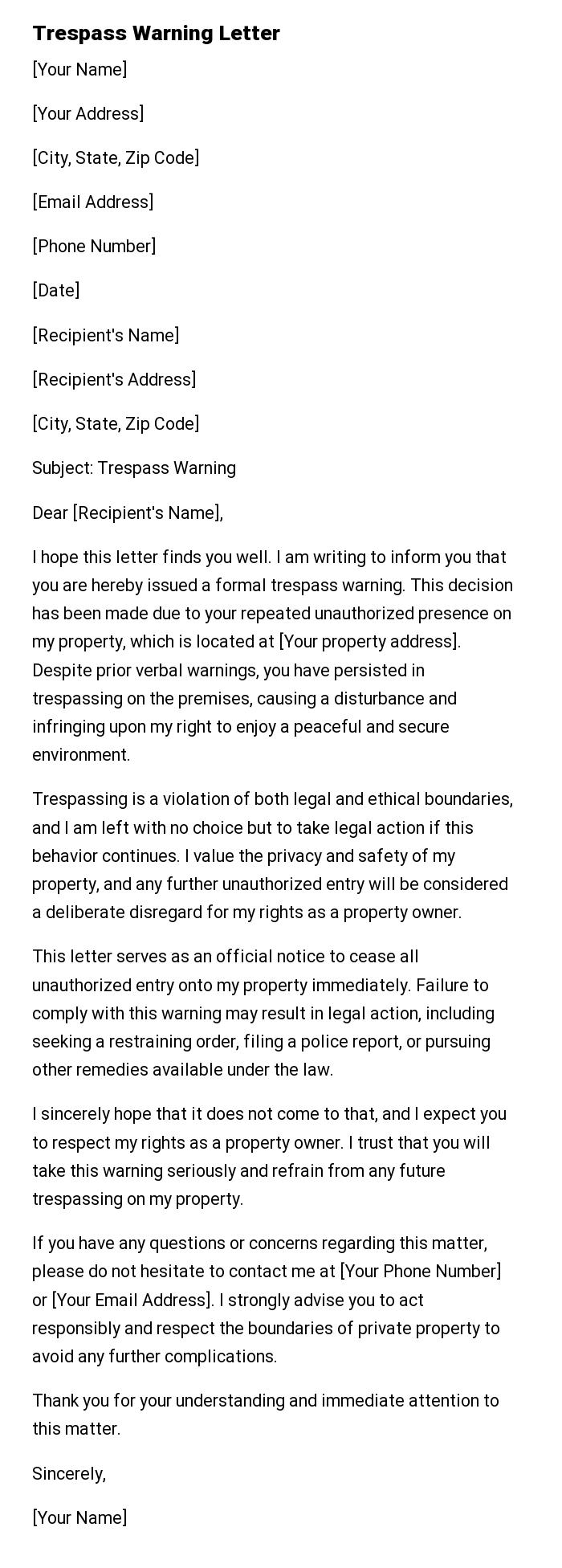
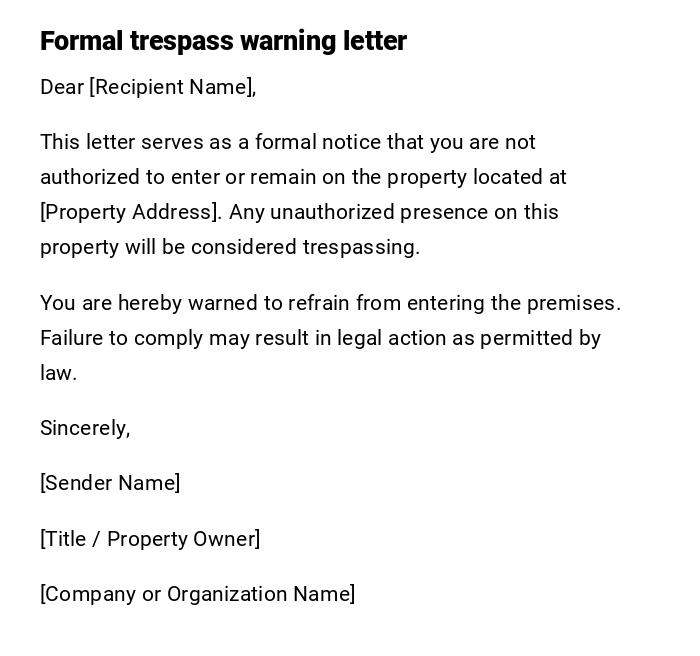
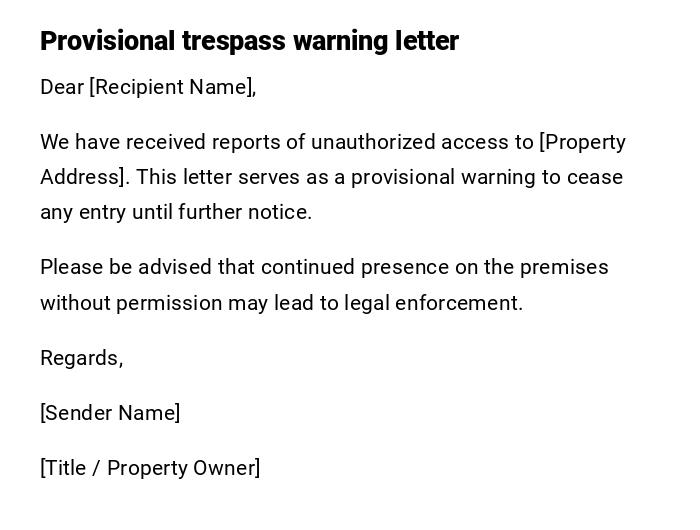
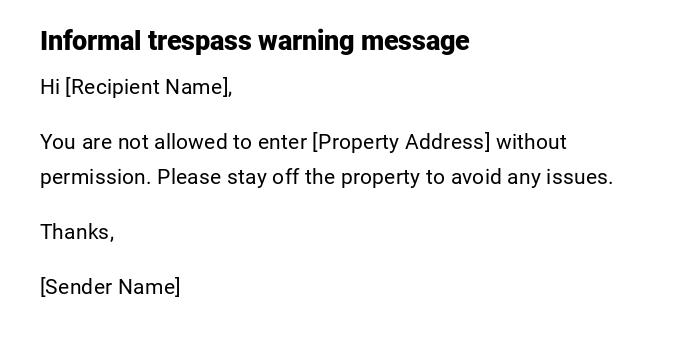
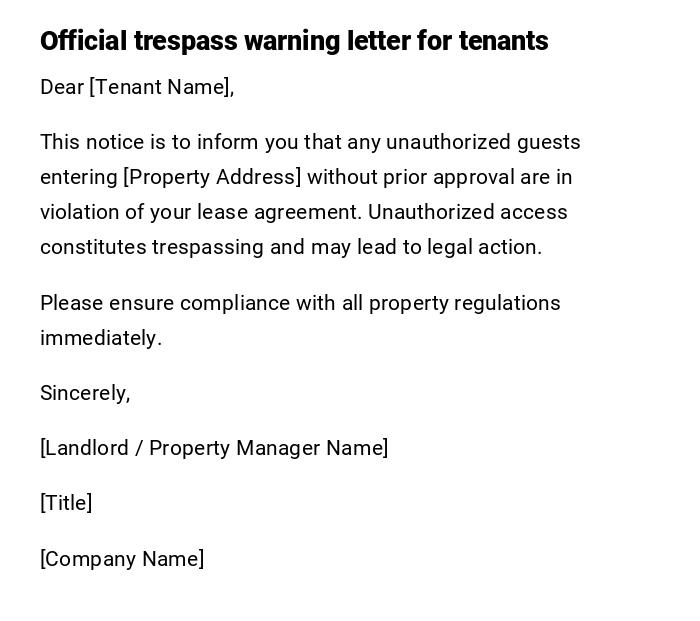
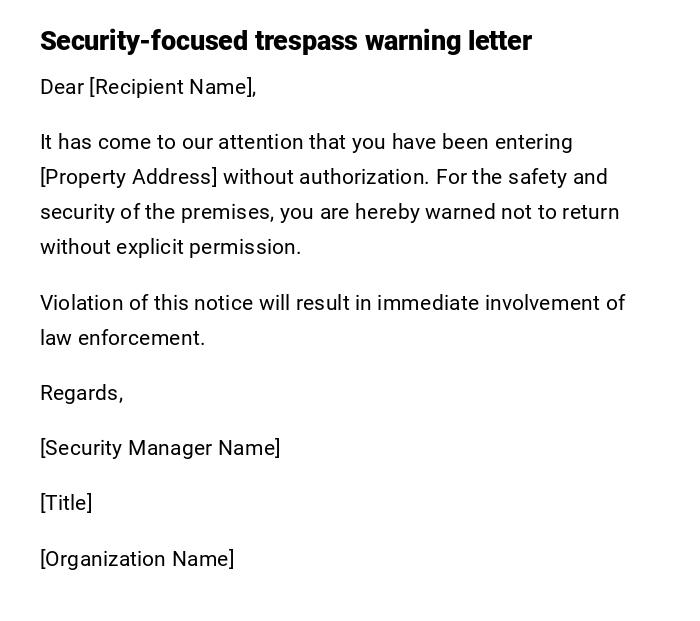
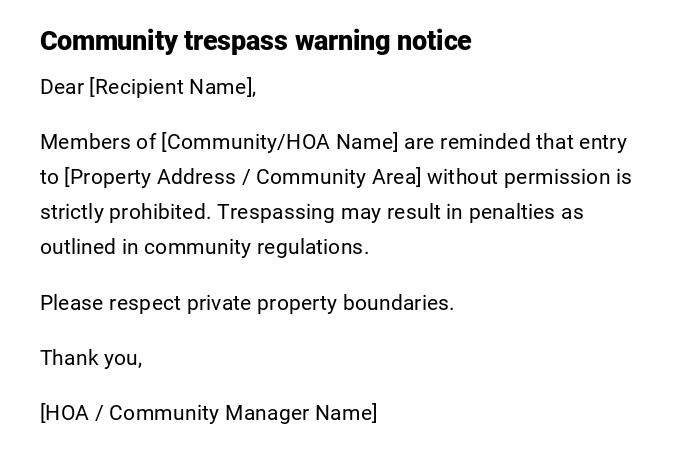
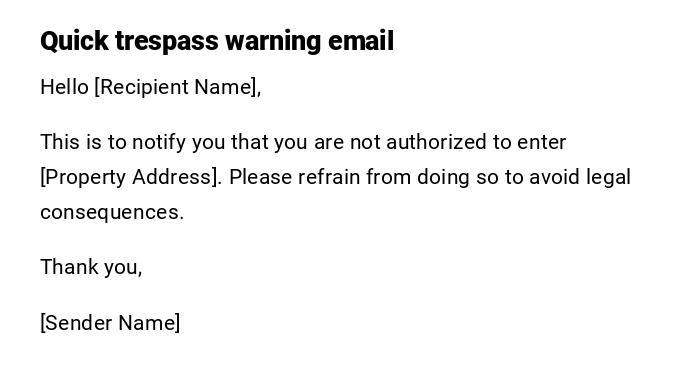
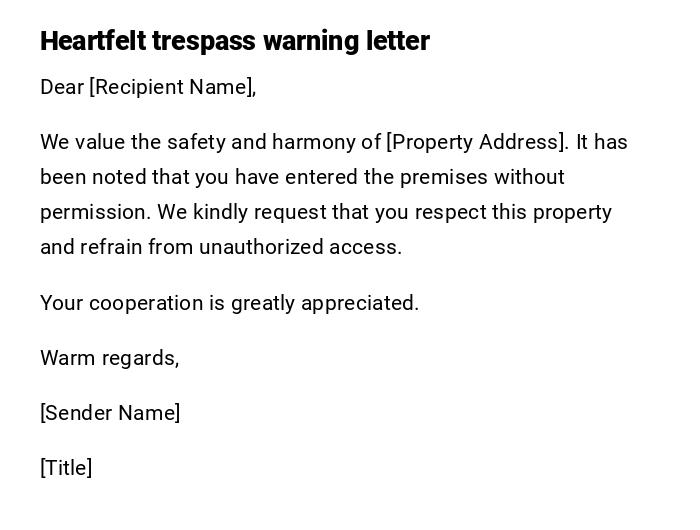

 Download Word Doc
Download Word Doc
 Download PDF
Download PDF